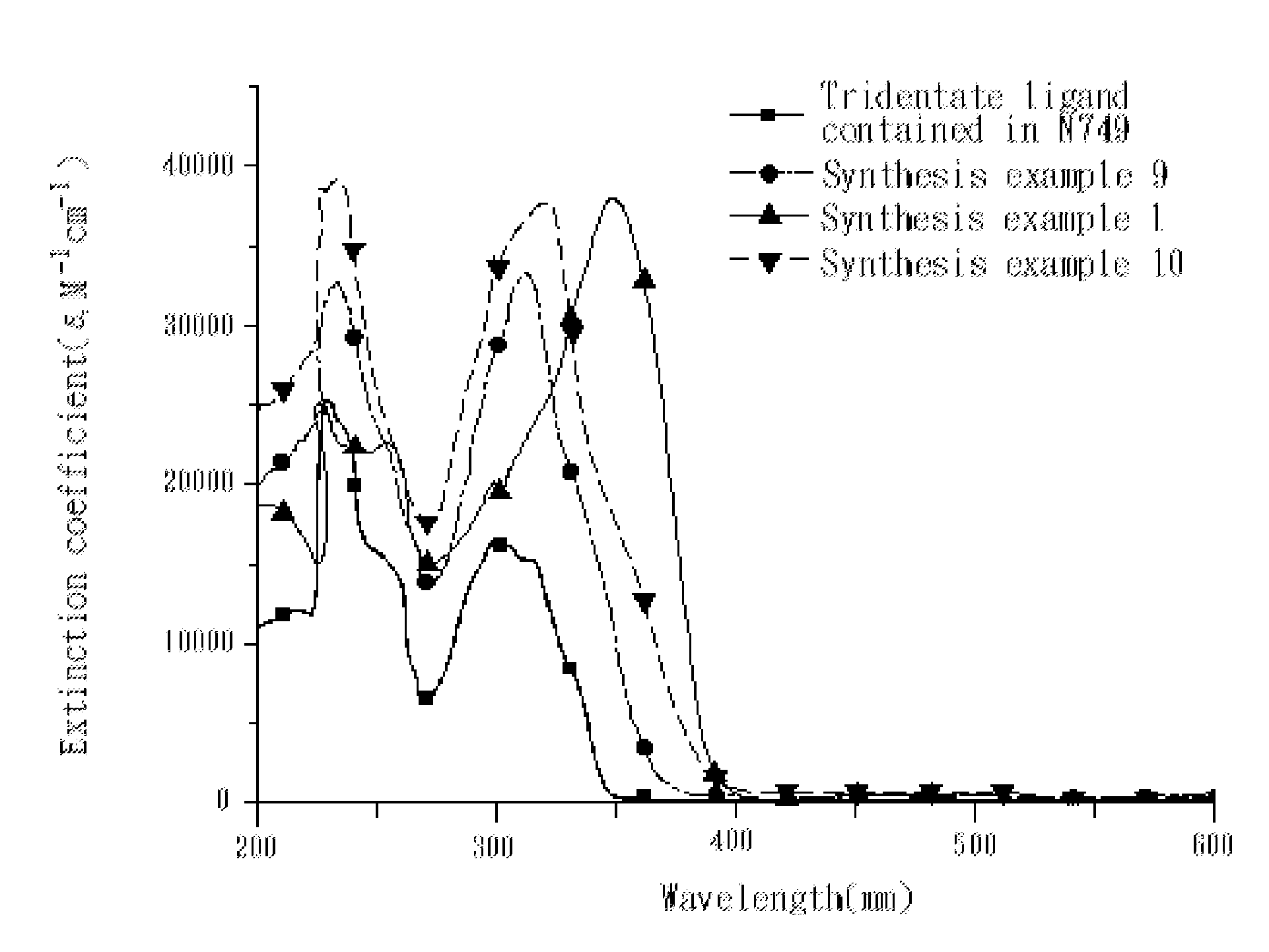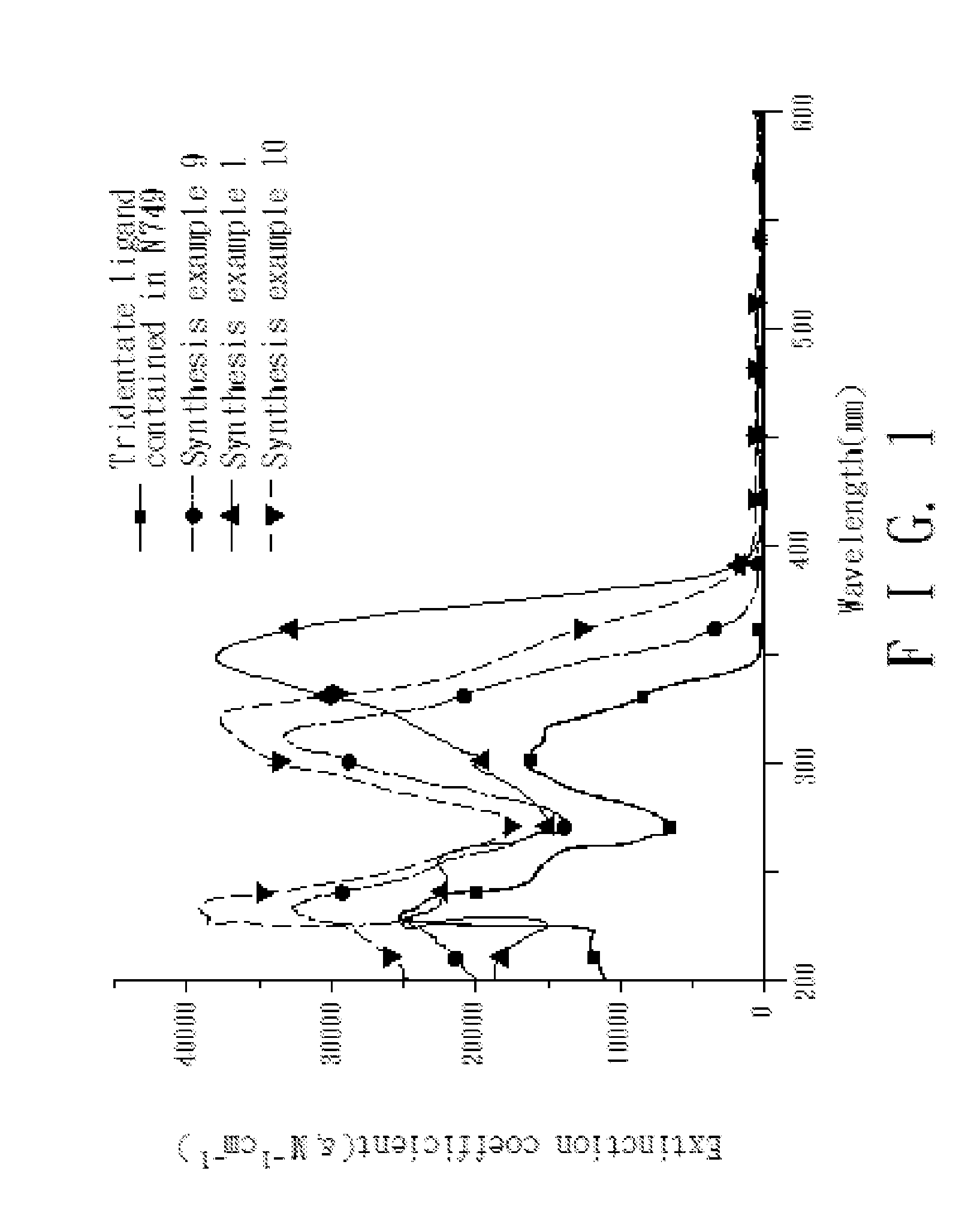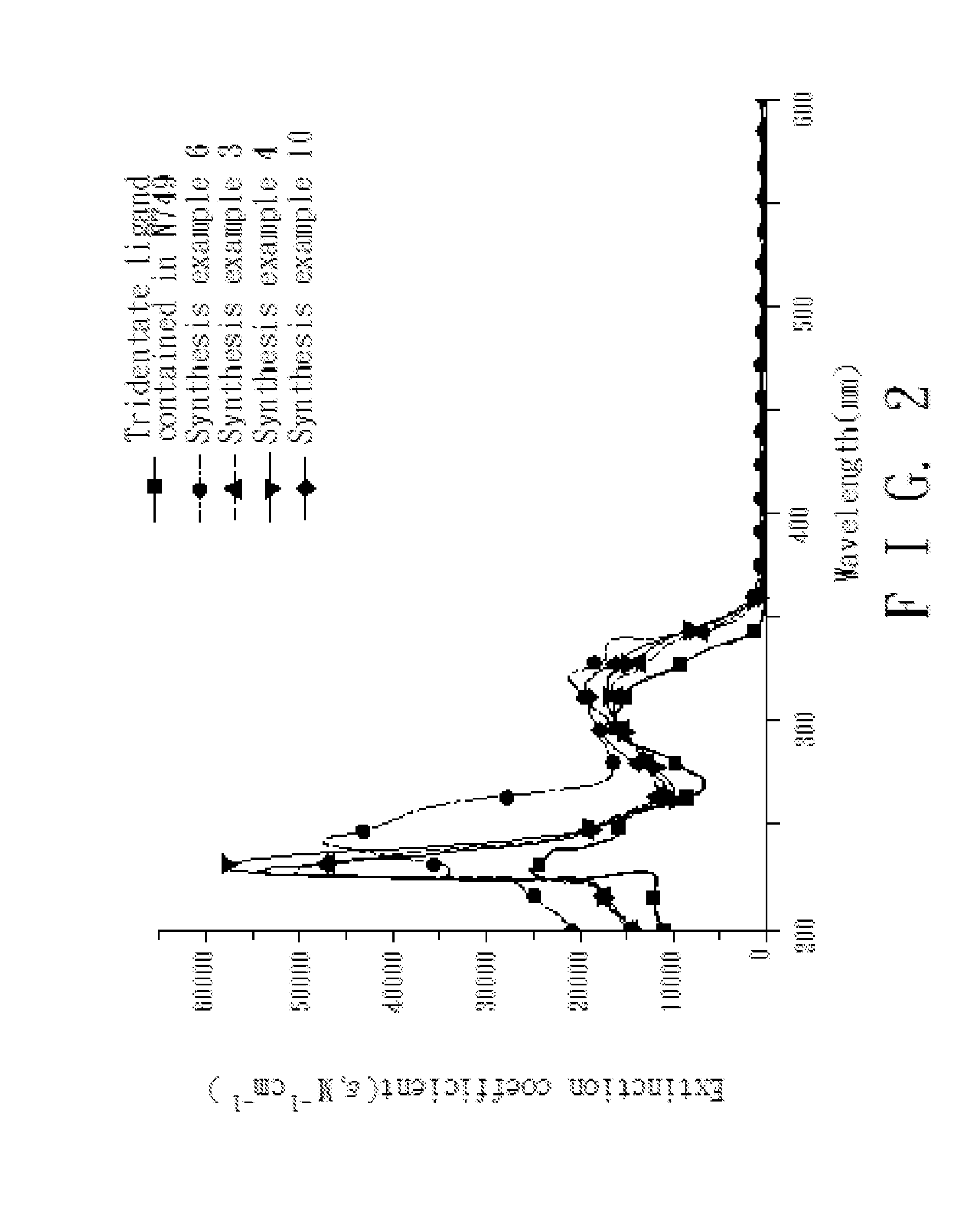4,4'-dicarboxy-2,2'-bipyridine derived tridentate ligand, metal complex containing the same, and application thereof
a tridentate ligand and terpyridine technology, applied in the field of tridentate ligands, can solve the problems of insufficient solar light to be converted into electrical energy via photovoltaic cells, primarily affected by the photovoltaic conversion efficiency of dssc, and the inability of terpyridine ligand to effectively bond to the anode made of titanium dioxide nanoparticles, etc., to achieve enhanced extinction coefficient and improved conjugation
- Summary
- Abstract
- Description
- Claims
- Application Information
AI Technical Summary
Benefits of technology
Problems solved by technology
Method used
Image
Examples
preparation example 1
[0084]4-ethylpyridine (125 mL) was added into a 150 mL one-necked flask, and was distilled at a temperature of 55° C. under a pressure of 0.2 torr to obtain purified 4-ethylpyridine. Purified 4-ethylpyridine (90 mL) and Pd / C (10 g) were metered into another 150 ml one-necked flask, and were refluxed at a temperature of 190° C. under an argon atmosphere for 9 days. The temperature in the flask was reduced to room temperature and Pd / C was filtered out to obtain a filtrate, which was purified via Kugelrohr filtration at a temperature of 180° C. under a pressure of 0.2 torr to obtain a colorless liquid (33 g), which was confirmed to be 4,4′-diethyl-2,2′-bipyridine (yield: 39.34%).
[0085]Spectral analysis data of 4,4′-diethyl-2,2′-bipyridine: 1H NMR (400 MHz, CDCl3, 298 K), δ (ppm): 8.54 (d, JHH=8.0 Hz, 2H), 8.22 (d, JHH=8.0 Hz, 2H), 7.12 (s, 2H), 2.70 (q, JHH=8.0 Hz, 4H), 1.28 (t, JHH=8.0 Hz, 6H).
[0086]4,4′-diethyl-2,2′-bipyridine (3 g, 14.1 mmol) was added into a 500 mL conical flask. C...
preparation example 2
[0096]2-hexylthiophene (4.29 g, 25.5 mmol) was added into a 150 ml two-necked flask, which was then purged with nitrogen three times. Anhydrous tetrahydrofuran (referred to as THF hereinafter) was then added. The temperature was reduced to −78° C. n-BuLi (12.21 mL, 30.5 mmol) was slowly added. Stirring was conducted for 30 minutes. 2-isopropoxy-4,4,5,5-tetramethyl-1,3,2-dioxaborolane (6.05 mL, 30.5 mmol) was then added. The temperature was slowly raised to room temperature, and stirring was conducted for 6 hours. THF was removed under reduced pressure, and methylene chloride was added. An organic layer was obtained after washing with a saline solution. The solvent was removed under reduced pressure to obtain a pink oil (5.57 g, yield: 75.8%).
[0097]Spectral analysis data of the pink oil: 1H NMR (400 MHz, CDCl3, 298K), δ (ppm): 7.45 (d, JHH=3.2 Hz, 1H), 6.84 (d, JHH=3.2 Hz, 1H), 2.85 (t, JHH=8.0 Hz, 2H), 1.70˜1.63 (m, JHH=8.0 Hz, 2H), 1.23˜1.31 (m, 16H), 0.91˜0.85 (m, 5H). The chemica...
preparation example 3
[0100]3,4-ethylenedioxythiophene (3.5 g, 24.6 mmol) was added into a 250 mL two-necked flask, which was then purged with nitrogen three times. Anhydrous THF was added. The temperature was reduced to −78° C. n-BuLi (10.4 mL, 23.42 mmol) was slowly added, and stirring was conducted for 30 minutes. 1-bromohexane (3.81 mL, 23.42 mmol) was slowly added. The temperature was slowly raised to room temperature, and stirring was conducted for 6 hours. Solvent was removed under reduced pressure, and methylene chloride was next added. An organic layer was obtained after washing with saline solution. The solvent was removed under reduced pressure and the crude product was purified by column chromatography (using ethyl acetate:hexane=1:20 as eluent) to obtain a light yellow oil (2.1 g, yield: 39%).
[0101]Spectral analysis data of the light yellow oil: 1H NMR (400 MHz, CDCl3, 298K), δ (ppm): 6.09 (s, 1H), 4.15 (t, JHH=8.0 Hz, 4H), 2.60 (t, JHH=8.0 Hz, 2H), 1.61˜0.90 (m, 11H). The chemical structure...
PUM
| Property | Measurement | Unit |
|---|---|---|
| Electric potential / voltage | aaaaa | aaaaa |
| Electrical conductor | aaaaa | aaaaa |
Abstract
Description
Claims
Application Information
 Login to View More
Login to View More - R&D
- Intellectual Property
- Life Sciences
- Materials
- Tech Scout
- Unparalleled Data Quality
- Higher Quality Content
- 60% Fewer Hallucinations
Browse by: Latest US Patents, China's latest patents, Technical Efficacy Thesaurus, Application Domain, Technology Topic, Popular Technical Reports.
© 2025 PatSnap. All rights reserved.Legal|Privacy policy|Modern Slavery Act Transparency Statement|Sitemap|About US| Contact US: help@patsnap.com



